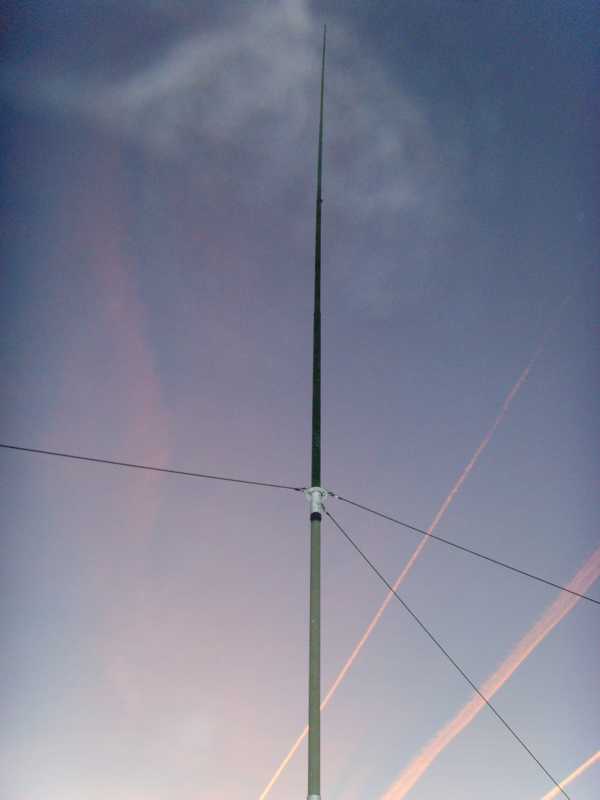I have been involved in the builds of several antennas in the last few years but in the main they have been the Antennas designed by SteppIR.
I have personally, or assisted in the building of the BigIR, the vertical by SteppIR (Photo – Below) which I owned for a while, and also of course the 2 element SteppIR which I still use. I assisted Steve MØOLD with the build of his  4 element SteppIR and then at North Wakefield Radio Club with their 4element which included the 30/40 kit (Photo – Below). Also included are the Cushcraft MA5B, the Comet H-422 and the Cushcraft D3W (30M & WARC Band rotatable dipole. Photos of all the builds can be found by looking further in the website plus also looking through ‘Gallery’ where other photographs can be viewed.
4 element SteppIR and then at North Wakefield Radio Club with their 4element which included the 30/40 kit (Photo – Below). Also included are the Cushcraft MA5B, the Comet H-422 and the Cushcraft D3W (30M & WARC Band rotatable dipole. Photos of all the builds can be found by looking further in the website plus also looking through ‘Gallery’ where other photographs can be viewed.
The SteppIR antenna was originally conceived to solve the problem of covering the 7 Amateur bands (40m, 20m, 17m, 15m, 12m, 10m and 6m) on one main tower without sacrificing the performance of them and also to avoid interaction that would occur should you try to mount several antennas on the same Tower.Yagi’s are available that cover 20 meters through 10 meters by using interlaced elements, traps or log periodic techniques, but do so at the expense of significant performance reduction in gain and front to back ratios. Now, with the addition of the WARC bands on 17m and 12m, the use of interlaced elements  and traps has clearly been an exercise in diminishing returns.
and traps has clearly been an exercise in diminishing returns.
Obviously, an antenna that is precisely adjustable in length while in the air would solve the frequency problem, and in addition, would have vastly improved performance over existing fixed length Beam antennas. The ability to tune the antenna to a specific frequency, without regard for band-width, results in excellent gain and front to back at every frequency.
Also offered with the SteppIR beam antennas is the ability to be able to change direction (180 degrees) at the push of a button and within 3 – 5 seconds. This prevents wear and tear on the rotator but the main benefit for me is time. In the time it takes you to turn your normal antenna 180 degrees, the SteppIR beam could have done it 6 to 8 times in the same period, truly amazing for optimum efficiency. The SteppIR design was made possible by the convergence of determination and high tech materials. The availability of new lightweight glass fibre composites,  Teflon blended thermo- plastics, high conductivity copper-beryllium (Photo – right) and extremely reliable stepper motors has allowed the SteppIR to be a commercially feasible product. There are questions on how it will survive the test of time, extreme cold temperatures and other variables but these cannot be answered with certainty, it would be wrong to do so. Some also
Teflon blended thermo- plastics, high conductivity copper-beryllium (Photo – right) and extremely reliable stepper motors has allowed the SteppIR to be a commercially feasible product. There are questions on how it will survive the test of time, extreme cold temperatures and other variables but these cannot be answered with certainty, it would be wrong to do so. Some also  question how they will stand up to the conventional trapped beams due to how many moveable parts there are involved in the design. Again it would be wrong to second guess the designers but they are highly confident all will be good in the future years.
question how they will stand up to the conventional trapped beams due to how many moveable parts there are involved in the design. Again it would be wrong to second guess the designers but they are highly confident all will be good in the future years.
At my QTH I only have the baby of the family, the 2 element SteppIR (Photo – Left). Performance wise it is amazing and I cannot complain at all. Clearly it will not compete with the larger SteppIR antennas but for my small station it’s perfectly adequate and will compete very well in a pile up against some of the more modest stations. On the lower bands I have a Comet H-422 trapped rotatable dipole erected above the 2 element SteppIR (Photo – Below & shown at 15ft) which I use solely for 40M and for 80M just a standard half wave Dipole at 15 feet.
Photos of these antennas can be seen in the ‘Gallery’ under ‘Home QTH’. Of course by now I have a good understanding of these antennas as regards performance and building. If you are wanting technical support then contact the UK importer of SteppIR Antennas, Ron Stone at Vine Antennas http://www.vinecom.co.uk/ . Any general enquiriesor maybe you would like to see some photographs in more detail then by all means drop me a line and i will be happy to help if possible, contact details in the Menu above.

73 de Charles
